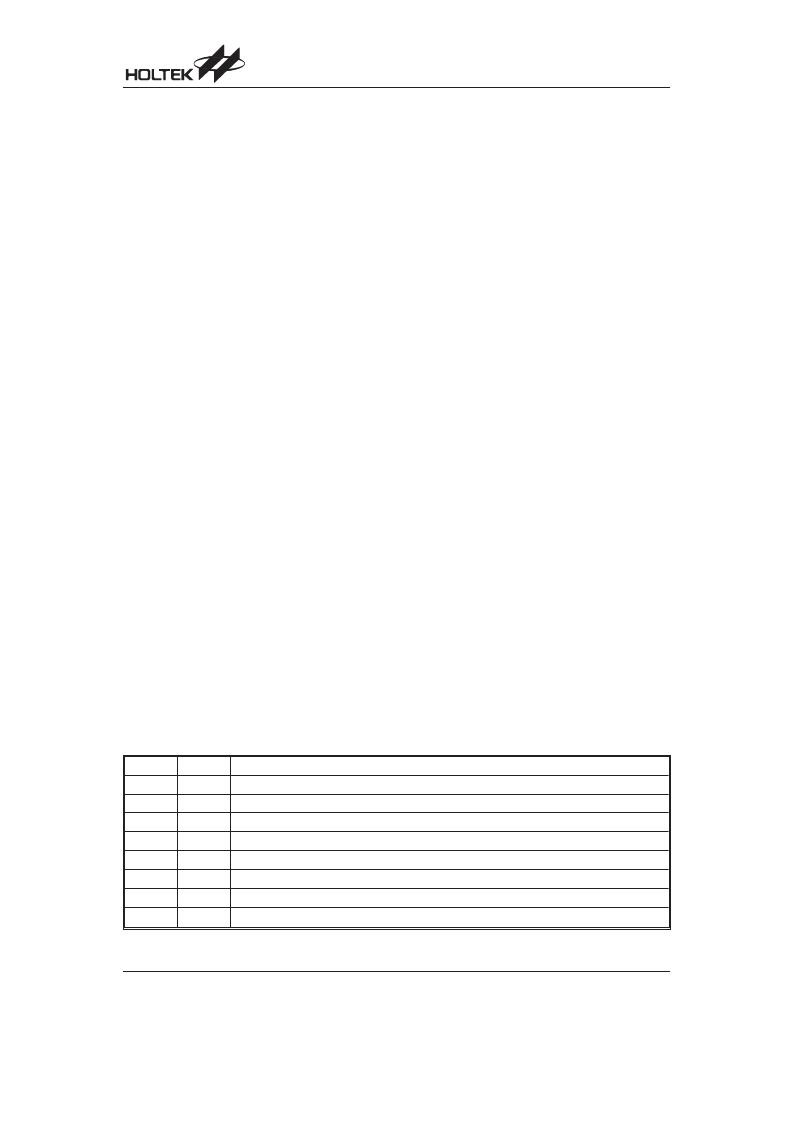- 您現(xiàn)在的位置:買賣IC網 > PDF目錄385404 > HT82K95AE (Holtek Semiconductor Inc.) USB Multimedia Keyboard Encoder 8-Bit MCU PDF資料下載
參數(shù)資料
| 型號: | HT82K95AE |
| 廠商: | Holtek Semiconductor Inc. |
| 英文描述: | USB Multimedia Keyboard Encoder 8-Bit MCU |
| 中文描述: | 的USB多媒體鍵盤編碼器8位微控制器 |
| 文件頁數(shù): | 10/45頁 |
| 文件大小: | 297K |
| 代理商: | HT82K95AE |
第1頁第2頁第3頁第4頁第5頁第6頁第7頁第8頁第9頁當前第10頁第11頁第12頁第13頁第14頁第15頁第16頁第17頁第18頁第19頁第20頁第21頁第22頁第23頁第24頁第25頁第26頁第27頁第28頁第29頁第30頁第31頁第32頁第33頁第34頁第35頁第36頁第37頁第38頁第39頁第40頁第41頁第42頁第43頁第44頁第45頁

HT82K95EE/HT82K95AE
Rev. 1.20
10
In addition, on entering the interrupt sequence or exe-
cuting the subroutine call, the status register will not be
pushed onto the stack automatically. If the contents of
the status are important and if the subroutine can cor-
rupt the status register, precautions must be taken to
save it properly.
Interrupt
The device provides an external interrupt and internal
timer/event counter interrupts. The Interrupt Control
Register (INTC;0BH) contains the interrupt control bits
tosettheenable/disableandtheinterruptrequestflags.
Once an interrupt subroutine is serviced, all the other in-
terrupts will be blocked (by clearing the EMI bit). This
schememaypreventanyfurtherinterruptnesting.Other
interrupt requests may occur during this interval but only
the interrupt request flag is recorded. If a certain inter-
rupt requires servicing within the service routine, the
EMI bit and the corresponding bit of the INTC may be set
to allow interrupt nesting. If the stack is full, the interrupt
request will not be acknowledged, even if the related in-
terruptisenabled,untiltheSPisdecremented.Ifimmedi-
ate service is desired, the stack must be prevented from
becoming full.
All these kinds of interrupts have a wake-up capability.
As an interrupt is serviced, a control transfer occurs by
pushing the program counter onto the stack, followed by
a branch to a subroutine at specified location in the pro-
gram memory. Only the program counter is pushed onto
the stack. If the contents of the register or status register
(STATUS) are altered by the interrupt service program
which corrupts the desired control sequence, the con-
tents should be saved in advance.
USB interrupts are triggered by the following USB
events and the related interrupt request flag (USBF; bit
4 of the INTC) will be set.
The corresponding USB FIFO is accessed from the
PC
The USB suspends signal from the PC
The USB resumes signal from the PC
The USB sends Reset signal
When the interrupt is enabled, the stack is not full and
the external interrupt is active, a subroutine call to loca-
tion 04H will occur. The interrupt request flag (USBF)
and EMI bits will be cleared to disable other interrupts.
When the PC Host access the FIFO of the HT82K95EE/
HT82K95AE, the corresponding request bit of the USR
is set, and a USB interrupt is triggered. So user can eas-
ily decide which FIFO is accessed. When the interrupt
has been served, the corresponding bit should be
cleared by firmware. When the HT82K95EE/
HT82K95AE receives a USB Suspend signal from the
Host PC, the suspend line (bit0 of the USC) of the
HT82K95EE/HT82K95AE is set and a USB interrupt is
also triggered.
Also when the HT82K95EE/HT82K95AE receives a Re-
sume signal from the Host PC, the resume line (bit3 of
the USC) of HT82K95EE/HT82K95AE is set and a USB
interrupt is triggered.
Whenever a USB reset signal is detected, the USB in-
terrupt is triggered.
The internal Timer/Event Counter 0 interrupt is initial-
ized by setting the Timer/Event Counter 0 interrupt re-
quest flag (; bit 5 of INTC), caused by a timer 0 overflow.
When the interrupt is enabled, the stack is not full and
the T0F bit is set, a subroutine call to location 08H will
occur. The related interrupt request flag (T0F) will be re-
setandtheEMIbitclearedtodisablefurtherinterrupts.
The internal Timer/Even Counter 1 interrupt is initialized
by setting the Timer/Event Counter 1 interrupt request
flag (;bit 6 of INTC), caused by a timer 1 overflow. When
the interrupt is enabled, the stack is not full and the T1F
is set, a subroutine call to location 0CH will occur. The
related interrupt request flag (T1F) will be reset and the
EMI bit cleared to disable further interrupts.
During the execution of an interrupt subroutine, other in-
terrupt acknowledge signals are held until the RETI in-
struction is executed or the EMI bit and the related
interrupt control bit are set to 1 (if the stack is not full).
To return from the interrupt subroutine, RET or RETI
may be invoked. RETI will set the EMI bit to enable an in-
terrupt service, but RET will not.
Bit No.
Label
Function
0
EMI
Controls the master (global) interrupt (1= enabled; 0= disabled)
1
EUI
Controls the USB interrupt (1= enabled; 0= disabled)
2
ET0I
Controls the Timer/Event Counter 0 interrupt (1= enabled; 0= disabled)
3
ET1I
Controls the Timer/Event Counter 1 interrupt (1= enabled; 0= disabled)
4
USBF
USB interrupt request flag (1= active; 0= inactive)
5
T0F
Internal Timer/Event Counter 0 request flag (1= active; 0= inactive)
6
T1F
Internal Timer/Event Counter 1 request flag (1= active; 0= inactive)
7
Unused bit, read as 0
INTC (0BH) Register
相關PDF資料 |
PDF描述 |
|---|---|
| HT82K95EE | USB Multimedia Keyboard Encoder 8-Bit MCU |
| HT82K95A | USB Multimedia Keyboard Encoder 8-Bit MCU |
| HT82K95E | USB Multimedia Keyboard Encoder 8-Bit MCU |
| HT82K96A | USB Multimedia Keyboard Encoder 8-Bit Mask MCU |
| HT82K96E | 8-Bit USB Multimedia Keyboard Encoder OTP MCU |
相關代理商/技術參數(shù) |
參數(shù)描述 |
|---|---|
| HT82K95E | 制造商:HOLTEK 制造商全稱:Holtek Semiconductor Inc 功能描述:USB Multimedia Keyboard Encoder 8-Bit MCU |
| HT82K95EE | 制造商:HOLTEK 制造商全稱:Holtek Semiconductor Inc 功能描述:USB Multimedia Keyboard Encoder 8-Bit MCU |
| HT82K96A | 制造商:HOLTEK 制造商全稱:Holtek Semiconductor Inc 功能描述:USB Multimedia Keyboard Encoder 8-Bit Mask MCU |
| HT82K96E | 制造商:HOLTEK 制造商全稱:Holtek Semiconductor Inc 功能描述:8-Bit USB Multimedia Keyboard Encoder OTP MCU |
| HT82K96E_07 | 制造商:HOLTEK 制造商全稱:Holtek Semiconductor Inc 功能描述:USB Multimedia Keyboard Encoder 8-Bit OTP MCU |
發(fā)布緊急采購,3分鐘左右您將得到回復。